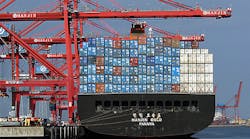President Donald Trump’s focus on curbing the trade deficit by bolstering U.S. exports and reducing imports could drive policy changes that impact industrial real estate markets throughout the U.S., Cushman & Wakefield reported in a logistics and industrial research briefing released on April 17.
However, the report concludes that a trade war with China or U.S. withdrawal from NAFTA remain unlikely.
“President Trump says he believes in ‘free trade but also fair trade,’ and as policy details emerge, companies will start looking at their supply chain networks to determine the impact on operating costs,” said Jason Tolliver, head of Industrial Research, Americas at Cushman & Wakefield.
“The importance of China, Mexico and Canada as export partners makes withdrawal from the North American Free Trade Agreement or a trade war with China unlikely scenario,” added Tolliver.
The U.S. is engaged in complicated trade obligations with 20 countries through 14 free trade agreements. Free trade partners account for nearly 70% of U.S. exports and more than 80% of imports.
The report considered two executive orders Trump recently signed to make trade policy tougher on foreign governments that subsidize companies that sell goods at below-market prices and calling for the Commerce Department to produce a report on every possible reason for the trade deficit in 90 days.
Cushman & Wakefield’s industrial research weighs the impact of trade with China – the U.S.’s second largest trading partner and its third largest export market as well as a driver of the industrial-related warehouse demand in this country – and concludes that China remains too important of a trade partner for the U.S. to engage in a trade war.
“China’s growing consumer class will exceed the entire U.S. population by 2026,” said Tolliver. “Similarly, when you consider the impact of increased cross-border trade flows between Canada, Mexico and the U.S. since NAFTA, it seems unlikely the U.S. would withdraw.”
All three NAFTA partners recognize the need to update the agreement, Tolliver noted. However, the Cushman & Wakefield report notes that U.S. trade with Canada and Mexico has increased more rapidly than with any other countries since the signing of NAFTA in 1995, and U.S. warehouse inventory has increased by a net of 3.5 billion square feet.



